As we learned during our four weeks of volunteering with Habitat for Humanity in Colorado last summer, framing is the most rewarding part of house building. In just a few weeks a bare foundation and a pile of lumber take on the shape of a house — albeit the stick-figure outline of a house drawn by a child.
In our case, building a house on pilings in a coastal zone requires some extra steps and extra care. The first step is installing floor trusses across the concrete pilings to build the base of the house, securely bolting them down to the concrete to assist with wind resistance. Floor decking on top of the floor trusses creates a solid work surface to start building the vertical components (known to those of us in the trade as walls).
One of the many things we like about our builder is his willingness to let us hang around the jobsite and help out. Once the floor decking went into place, we have been welcome to participate in the build. Spending one or two mornings each week working on the house keeps us entertained, gives us the satisfaction of participating in the process, and is helping fuel our excitement about the future house.
The crew has been very adept at finding tasks that match our skill set. Sometimes our best value-add is handing up materials, moving lumber around or, recently, measuring and drawing lines on plywood sheathing. We recognize that some of this work is probably only adding 5-10% efficiency to the crew’s work, but that’s not too bad for volunteers. Frankly, our only real goal is to not be in the way. We’ve also built some corners and T-intersections for the exterior walls and helped raise walls. Our biggest contribution so far was on the day the crane was on site to install roof trusses. We served as ground crew, hooking the crane’s line to the trusses and working the tag line to maneuver the large spans into place while the pros perched on the roof and secured the trusses to the walls and to each other. The two of us collectively substituted for one pro, our best performance yet and one that earns top photo billing in this post!
Being on site while the bones of the house come together has given us a close-up view of several unusual components that make coastal houses strong and hurricane resistant. The corners of the exterior walls feature multiple studs of lumber assembled into a super-bundle of strong wood. Throughout the exterior walls there are 10+ foot long metal tie rods running from the top plate (along the top of the exterior walls) all the way down through the floor trusses. Metal brackets lock these tie rods to the floor trusses, which themselves are bolted into the concrete pilings. Every roof truss is strapped down to the exterior walls at both ends of the truss; each of those metal straps is attached to the wall with a minimum of eight nails and to the truss with a minimum of eight nails. All of this has made it very clear why we receive a steady stream of invoices for lumber and nails from the local building supply store.
Once the exterior walls and roof trusses were secured in place, it was time to finish the plywood sheathing that will serve as the decking for the roof and siding. With that layer in place, the house really takes shape. Next up: moisture barrier, roofing, and installation of doors and windows to dry in the house. We still have all our fingers and toes despite playing with power tools for several weeks, the weather is getting much nicer for outdoor work, and we are rolling along on our house build project. Things are looking up.
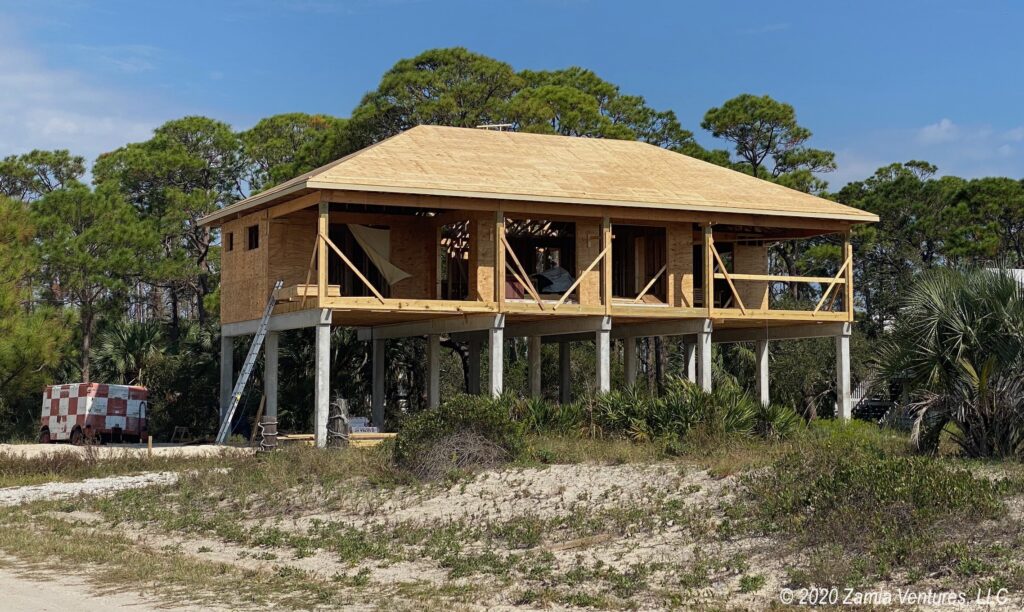
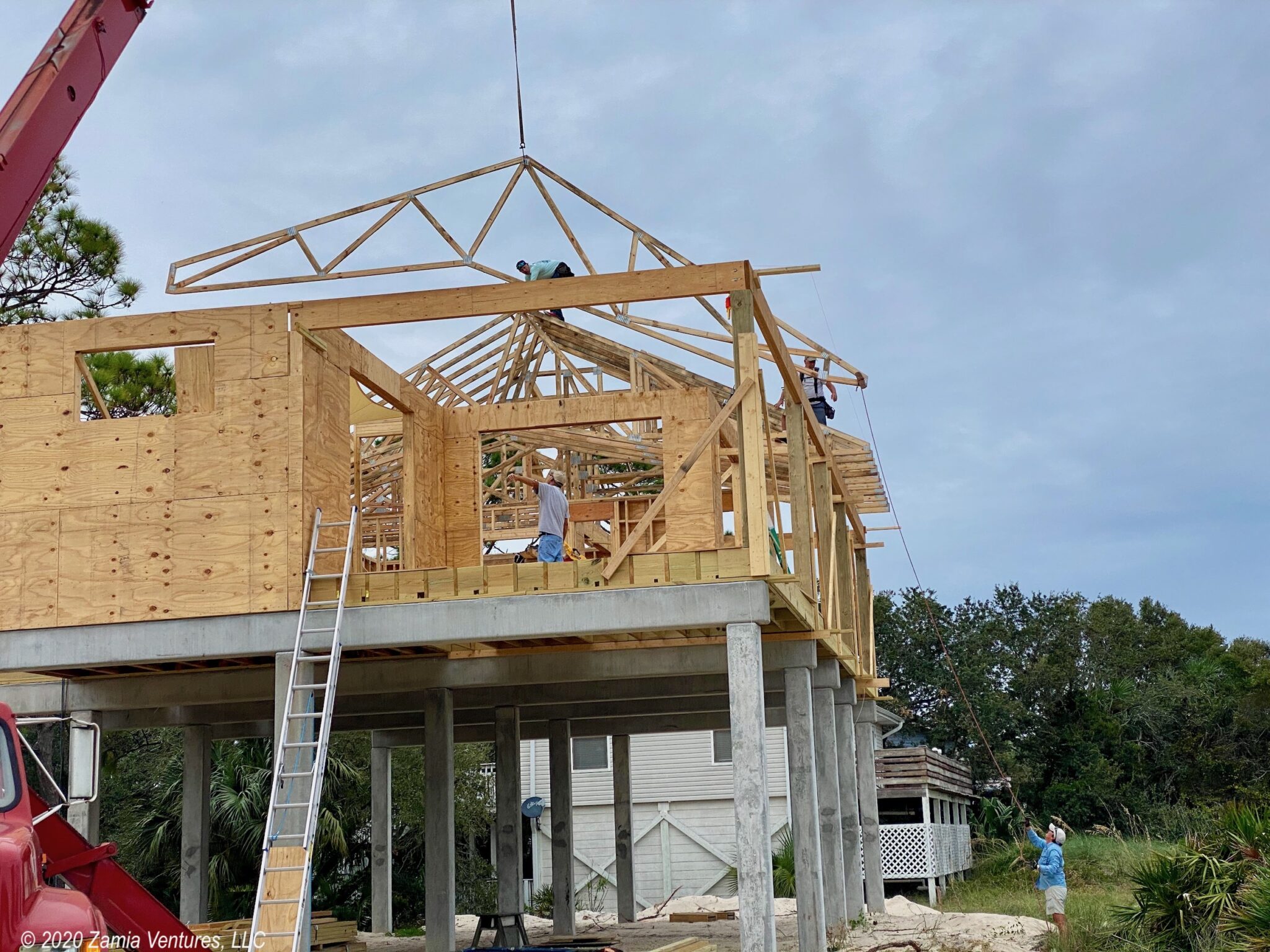
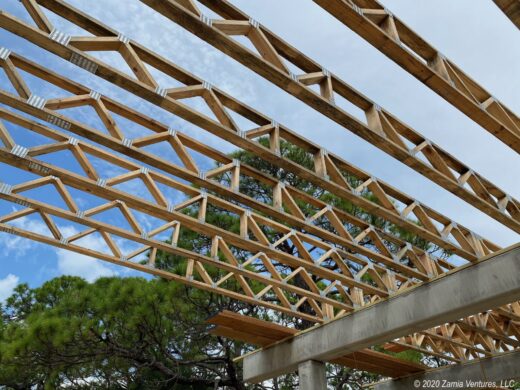
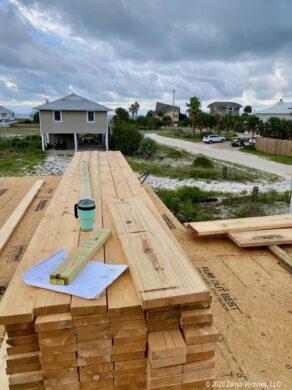
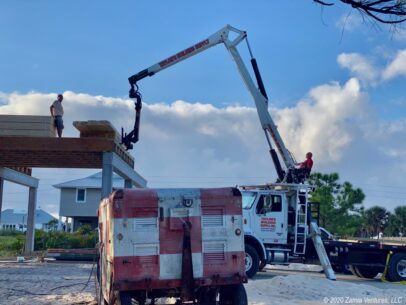
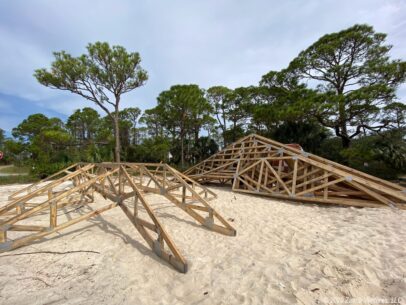
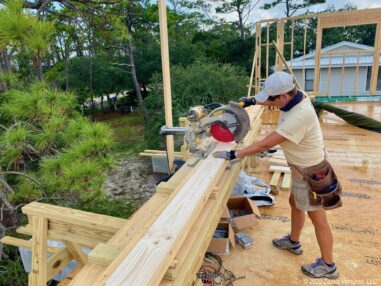
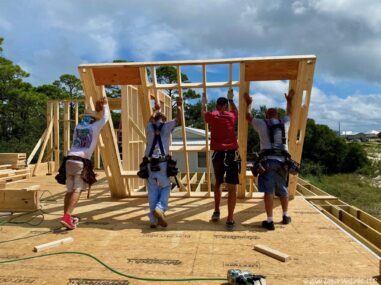
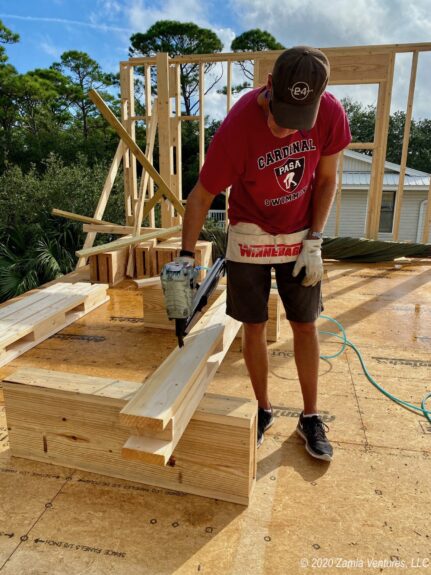
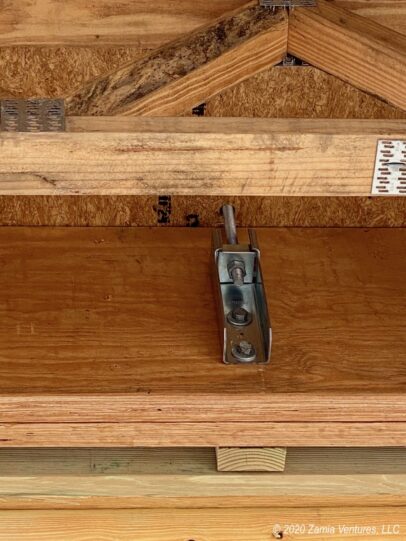
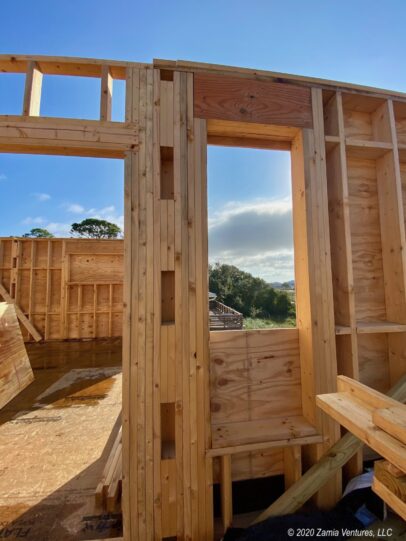
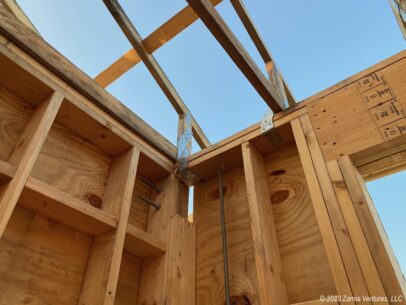
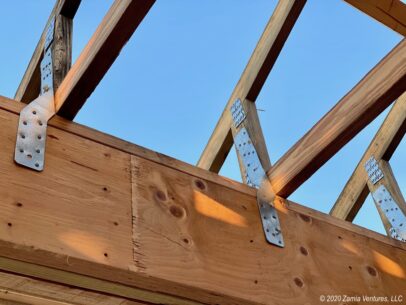

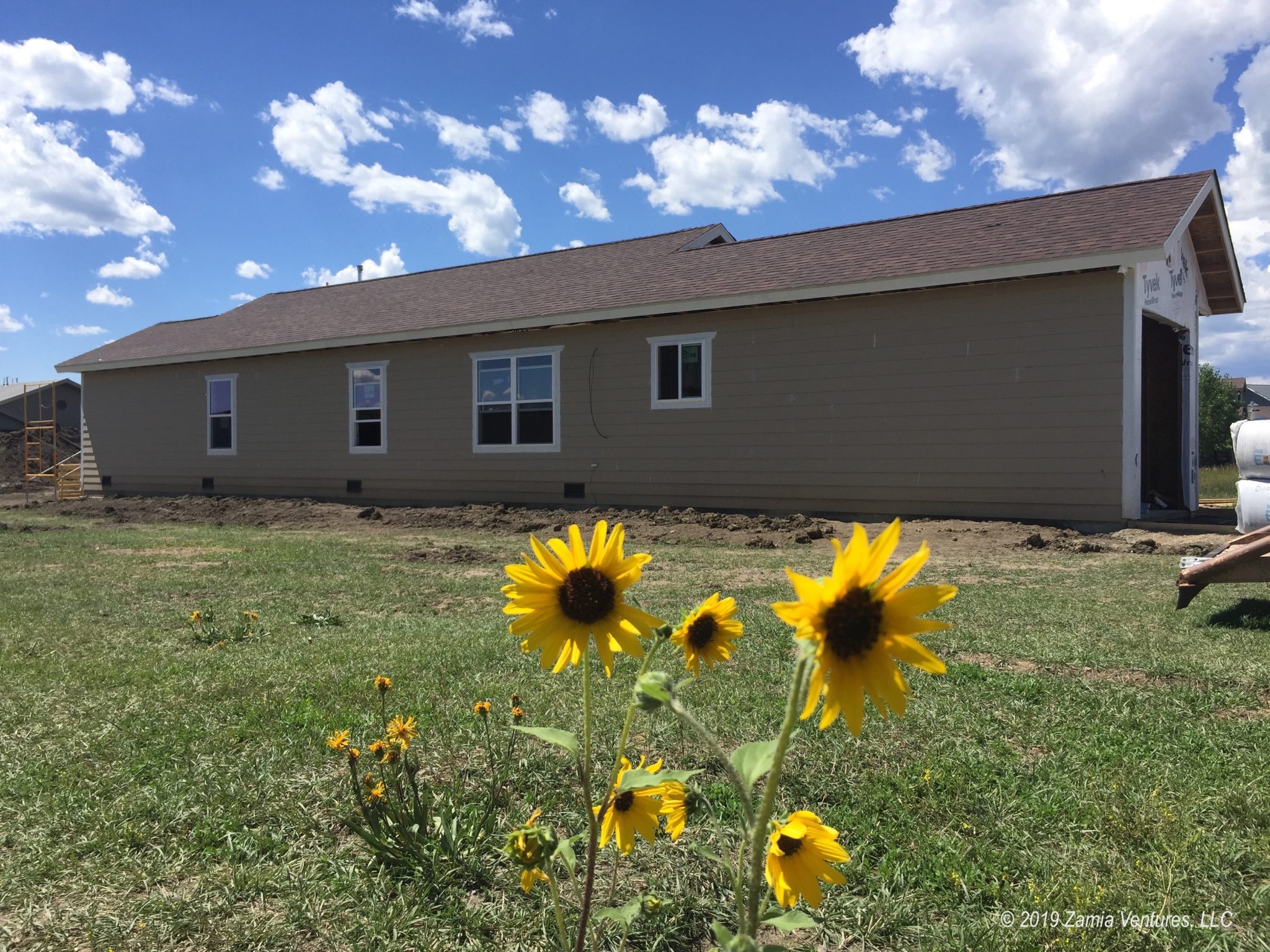
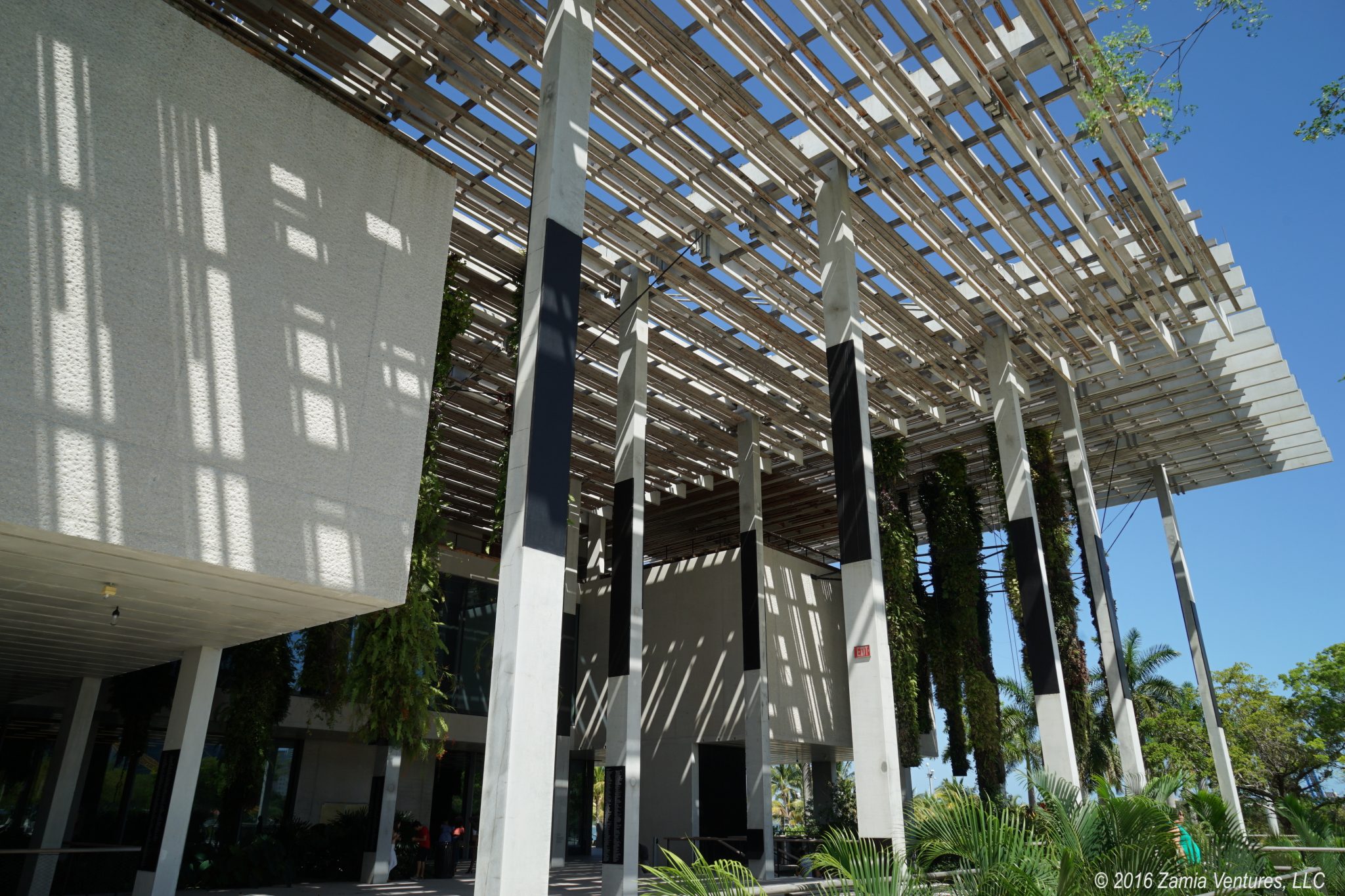
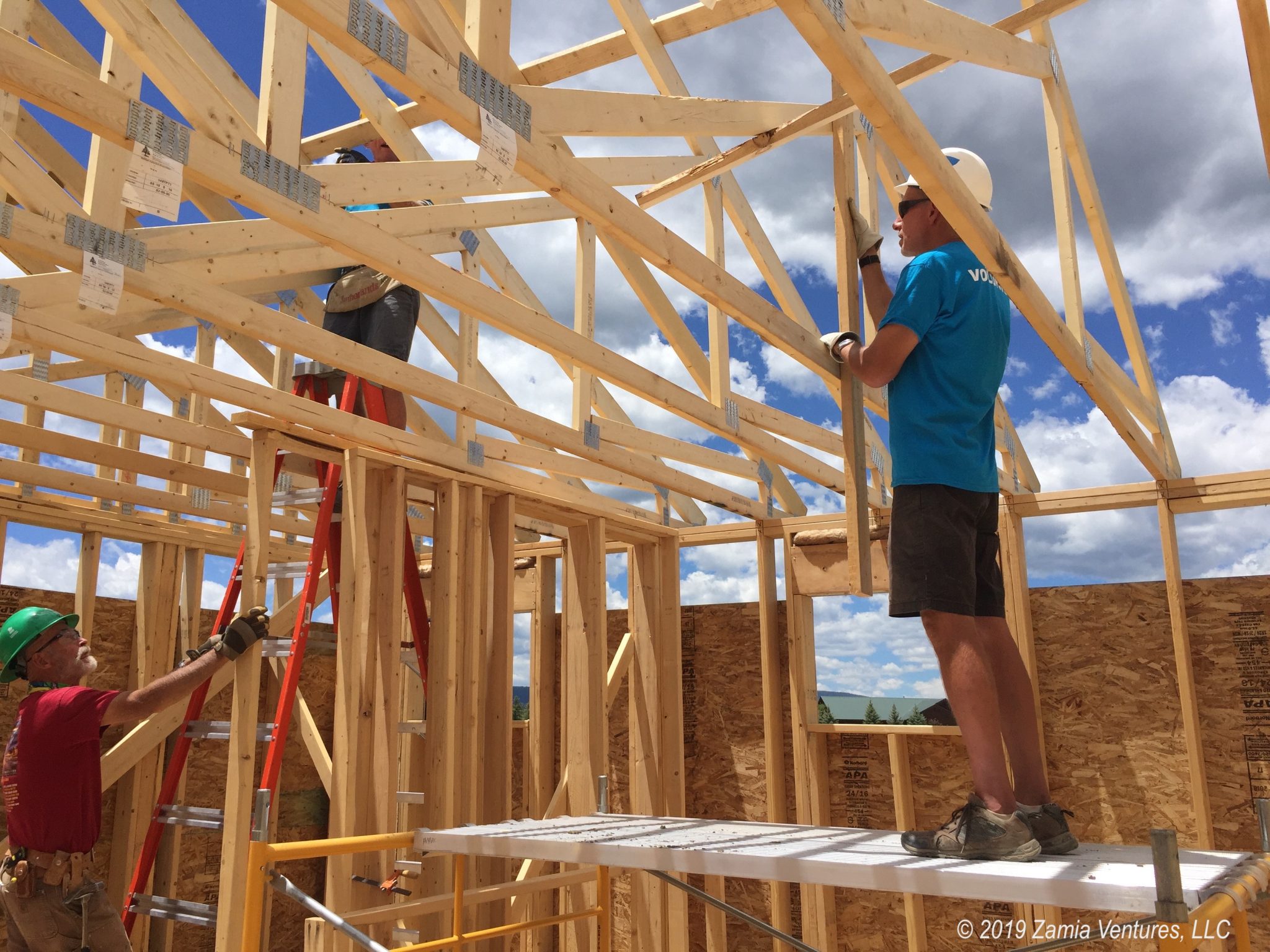
Hey, look, a house! Framing is definitely an exciting part of a build, when you can really see your plans take concrete shape. Before you know it, you’ll be picking out paint colors and doorknobs (if you haven’t already!) It’s also nice that you can hang around and help out. Blood, sweat, and tears make a house a home!
Happily, the 3-D version of the house is fulfilling the expectations we set when we spent long hours debating the plans. It’s very fun to see it all coming together. But I am a little apprehensive about the amount of shopping and selecting to be done. Deciding on the plans was manageable, but picking out appliances may kill us.
I am experiencing your first feelings about building a house Frank drew the blueprints and Mr. VAill, our neighbor and owner of the Watertown Lumber Company. Only one change was recommended and so we added one more window so we could look down our street so we could see the beautuful buildings of Taft School, a very expensive boys school. We started helping as soon as the hole was dug and added more drainage to the basement to prevent flooding. fortunately, it worked. GAil was about three years old and helped out. It was fun to see it starting to look like a house. Frank did all the electrical work and we preprinted the crab boards in the basement of the house we were living in. I find it very experiencing to read your excitement. Keep it up.
What great memories to have of building your life together with Frank. We are hoping to have the same sorts of memories of building a home together and (we hope) enjoying the house for years to come. Of course, we are not using child labor to build our place. 🙂 Stay tuned for more posts as the build progresses.
This is SO cool!! I’m enjoying seeing your house take shape, and reading about the process of how to hurricane-proof a house is fascinating. I’m glad Sterling is so open to having you and Ken help out. Knowing the ‘crew,’ I imagine that they are enjoying having you guys around. And you are seriously helping, you’re not just standing around!
How fun to actually play a role in building your own home in addition to picking out paint/flooring/windows/appliances/bathroom fixtures/lighting…oh yeah, and furniture. And making all of the decisions about where to put light switches and electrical outlets. It’s fun until it’s not, LOL. I’m still recovering from our stupid remodel and we’re not done yet. Come over for happy hour and we’ll commiserate. 🙂
We had hoped to participate in the build, and Sterling and Co. have been extremely welcoming…. more than we could have hoped. They pay attention to what we are doing so we don’t make big mistakes or do things in an unsafe way, but without hovering. We also try not to spend TOO much time onsite and make ourselves a nuisance. So far, it’s been a really good experience.
We are aware that it’s about to get much harder, as we will soon have to make many, many decisions. But I think RV living gave us a bone-deep understanding that furniture and other belongings are much less important than whether you have a happy home. So if we end up picking the “wrong” refrigerator or lights, we know that life will go on.
So this is very cool, but the lawyer in me has a question: Did you have to sign a waiver? Or a bunch of waivers? I feel like there should be a lot of waivers involved here. You know… cuz lawyers love their waivers????? On the one hand I’m all, “This is SO COOL! They can help build their own home and for all of eternity point to some nail in some wall and say “I put that there!”” But then I’m all “But the liability???” So, tell me, Miss Lawyer… Were there waivers involved??
Definitely interesting to see how they hurricane proof a house these days. I’m sure the first time you’re facing down a coastal storm, you’ll be more than happy to have paid the bills for all those nails. Just knowing how many lessons they’ve learned over the years and how they’re applying what they learned to the building of your house has to provide so much confidence.
It’s lookin good!!
Since you insist on knowing the details, YES, there is a waiver. The contract with our builder basically says that the homeowner is welcome to visit the work site but does so at his or her own risk, waiving all claims against the builder for injury. That being said, in this rural community most things happen via handshake and our construction contract is a mere 5 pages long so it would not be too surprising if there were no waivers at all. We just all carry our own insurance, and of course we cooperate with the builder and crew on when we plan to work. There are some particularly tricky or dangerous activities that the crew prefer us not to participate in, and that’s completely fine with us.
Our plans officially state that the house is rated for 140 mph winds, but we’re pretty confident that it would withstand much more. As a barrier island we are of course a mandatory evacuation zone if a storm approaches, but I think we would return to a basically unblemished house. That’s the goal, at least.
Sorry… not trying to be nosy. Just curious. Which I guess is kind of the same thing as being nosy…
Interesting to consider the small town impact on these transactions. Our motorhome is manufactured in a very tiny town in Alabama and they’ve always been famous for allowing owners to come watch the builds. Folks would just wander the factory floor, asking questions, and watching the process.
Just recently, the company outlawed the practice. They said it was because of their insurance company, but many have also wondered whether allowing visitors on the floor led to slowdowns in production – answering questions, making custom changes, etc. I can definitely see it from all sides. It would be awesome to know what’s behind this or that wall and how things were actually put together, but I can see the factory’s insurance company having a coronary over the practice, and I can imagine management saying “enough already” when demand is higher than ever and they’re trying to be efficient.
Either way though, something is lost with the change. The company got a lot of goodwill from their owners for allowing the practice and making it a very personalized experience. People got to know the folks doing the work and it felt like a transparent process. Now, that’s all gone away. It’ll be interesting to see if that has an impact on customer satisfaction down the line.
Hey, no problem with nosy questions here! Stuff on the blog is all fair game, even if I do secretly roll my eyes and think that only a lawyer could care about such things. 🙂
If I had to guess what happened with your RV manufacturer, I would say that a few jerks ruined it for everyone else. The vast majority of owners are excited to see the construction of their new motorhome, but also know how not to be a pest. Then there are a few who are too involved, too picky, too annoying, etc., and they make management just want to get rid of the onlookers altogether. Future motorhome owners probably won’t know what they missed by not being able to see the construction process, but still something is lost.
One of the many things we liked about our builder is that he turns away clients. He thinks he can tell immediately if someone is going to be troublesome, and he just turns down the project. The fact that he has enough work to be selective is obviously a strong recommendation, but the fact that he’s smart enough to avoid dealing with jerks is even more impressive. A few extra bucks are not worth the headache.
I am really enjoying all the comments about building a house. It reminds me of all the decisions that have to be made. After two years in our house, we decided to expand. Our oversize two car garage was converted into a very large family room with another bath and built in desk area as part of on office for sales meetings with his salesmen from all of New England. We also had blueprints to build a house on a lake in Peoria, Illinois. After building a new plant in Illinois for Enthone, the company decided to bring him back to CT as a Vice President. That started a fun time in Orange, CT with Vicki and Joe and the boys and our trips to Balch . Lake in New Hampshire. Ask Ken to tell you about our adventures. LOts of good memories. JAY
Trust me, we know about how many decisions need to be made! Just a remodel requires so much planning and selecting, and the project of building the whole house from scratch is even larger in scope. We are trying not to get too anxious about all the choices we need to make.